M13 - Hercules Globular Cluster
I was experimenting with UV/IR cut filters on the ZWO ASI071MC last night, and took a bunch of test subs without guiding--all 30 second exposures. This is 97 sub-exposures of M13 (NGC 6205) in the constellation Hercules. Messier 13, like most (all?) globular clusters orbit in the halo of the Milky Way galaxy, a good distance away from the core, both above and below the galactic plane.

And more stars (IC 4756 star cluster). More testing with the IR/UV cut filter and the ZWO ASI071MC camera.

Posted May 2, 2022
Messier 13
Hercules Globular Cluster (M13, NGC 6205) with the ZWOASI071 and SpaceCat 51. This is cropped quite a bit, but still not bad.

Posted May 16, 2021
Messing around with Messier in Infrared
We finally had several hours of clear night sky--not spectacular, but I'll take what I can get this time of year. That whole “April showers bring May flowers” thing really applies to this region of the planet. I think we’ve had four or five full clear nights in the last couple months--and I can’t remember multiple clear days in a row, but I am looking forward to more opportunities to capture the night skies soon--early summer through the winter.
One of the paths I’m currently on is to be more productive--in very concrete terms. I simply want to produce more imaging data per night than I have before. One way to do this is to upgrade equipment and pile on new devices, which translates into an EQ mount with more capacity and another scope and camera to double the exposure time. In other words, spend more money, which I don’t want to do.
Another option is to improve the efficiency of my current setup and systems. This is where I’m presently spending my time and effort, squeezing out 5-10 minutes per hour I was losing with slower hardware and application workflows (per image download times, auto-focus and plate-solving routines, etc). I will test out NINA (https://nighttime-imaging.eu) at some point, because I’ve heard great things about its speed. I’m currently using Sequence Generator Pro 3 with my narrowband refractor setup (William Optics GT81, Moonlite Focuser, ZWO ASI1600MM-Pro mono, and ASI120MM-Mini Guide-cam), and with a few exceptions and idiosyncrasies, which often turn out to be ASCOM or device-specific weirdness, not an SGP problem, things are going smoothly.
I have been working through a couple different configurations of equipment, automation systems, and application workflows, mostly focused on building a narrowband setup with two cables--USB3 and a single 12vdc 10 amp line. For now, I’m using Windows 10 on a fanless Celeron-based system, which easily handles the processing load during capture and plate-solving. On the scope itself I have the Moonlite Focuser controller, a powered USB 3 hub, and all power, environment, and dew control functions managed through a Pegasus Astro Pocket Powerbox.
I ran my first in-depth test of this system last night, jumping all over the sky east of the meridian, taking several 1-minute subs of M3, M10, M12, M13, M51, and NGC 6826 (blinking planetary nebula in Cygnus). I have to say, my impression of SGP has not changed. I already had a high opinion of it, and coming back to it for version 3 has been fun and exciting--and more importantly, productive. I was skipping all over the sky last night, pulling up the Framing and Mosaic wizard half a dozen times, and appending new targets to the sequence. I would have kept going after midnight, but the clouds rolled in and shut the show down.
Near-IR filter notes--something to consider if you’re guiding off-axis: I’m using Astronomik 1.25” narrowband filters (Ha, OIII, SII) in this ZWO EFW, but I also have an Optolong IR 685nm longpass filter installed in the 5th place. I ran into a slight issue with off-axis guiding because the IR filter’s focal offset with the Astronomik’s is so great that it throws off the focus of guide camera. I have to plan to do any near-IR exposures at the end of any sequence because this forces me to adjust the focus in PHD2 for the ZWO ASI120MM.
Here are a few shots from last night, using the Optolong 685nm longpass filter.
Whirlpool Galaxy (M51) in near-Infrared, WIlliam Optics GT81, ZWO ASI1600MM-Pro mono, 685nm Near-IR longpass filter. M51 is around 23 million lightyears away from us in the constellation Canes Venatici. It’s a tiny view of the galaxies, but I’m impressed with the trailing gas and dust that IR managed to capture.

M10 (NGC 6254) is a globular cluster of stars about 14,000 lightyears away in the constellation of Ophiuchus. 4 x 60 second subs in near-Infrared, William Optics GT81, ZWO ASI1600MM-Pro mono, 685nm Near-IR longpass filter. In IR the stars are really distinct in the cluster, and I want to come back with RGB and use the IR frames for luminance, and see how that looks.
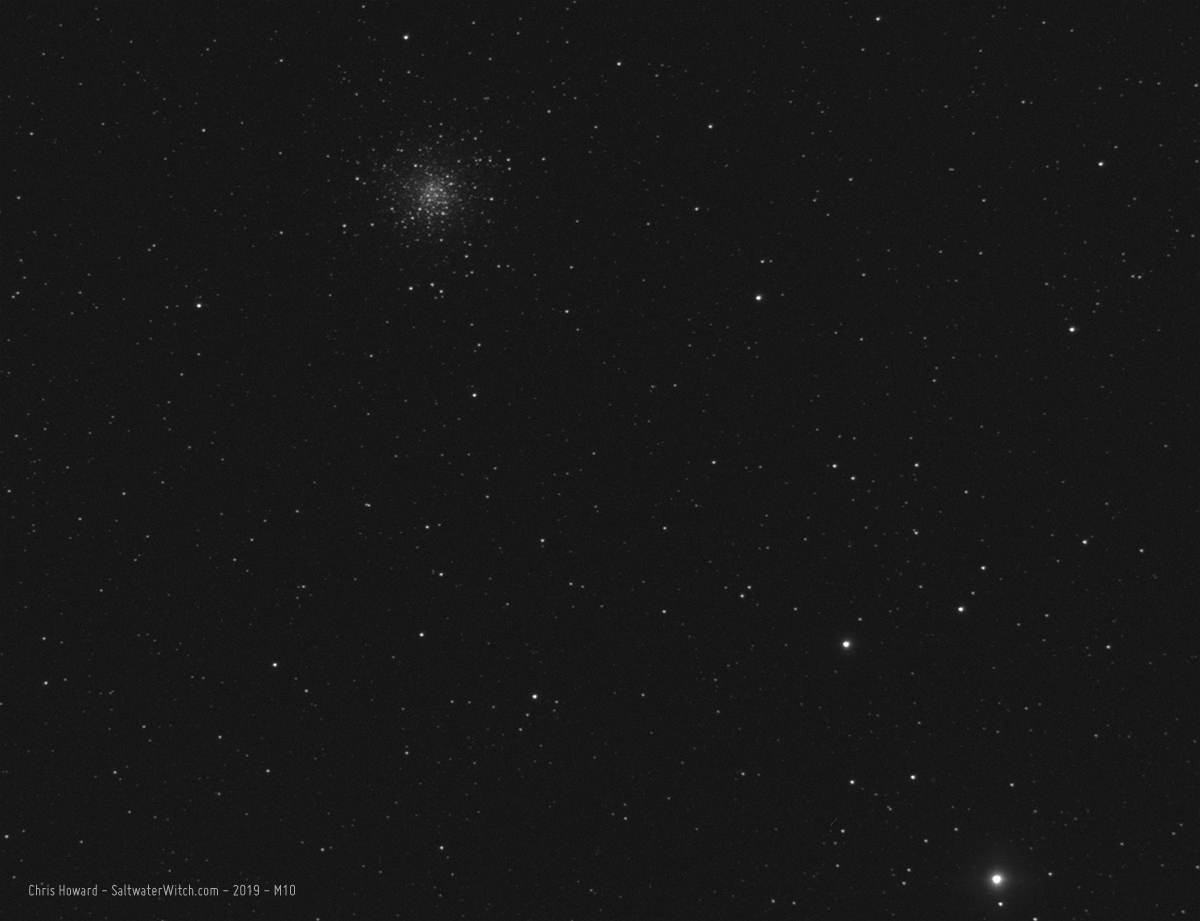
Messier 3 Cluster:
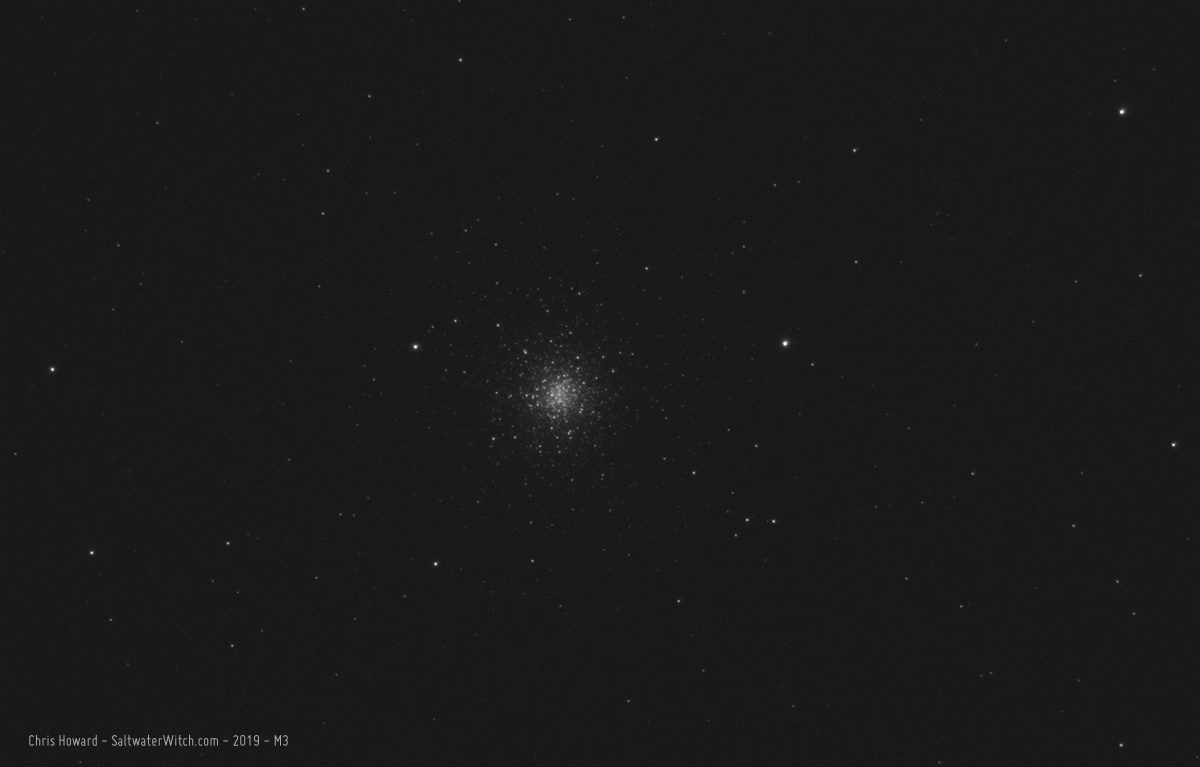
Messier 13 Cluster in Hercules:

Messier 13, Hercules Globular Cluster (also NGC 6205) - using the IR image as luminance with an old RGB version of M13:
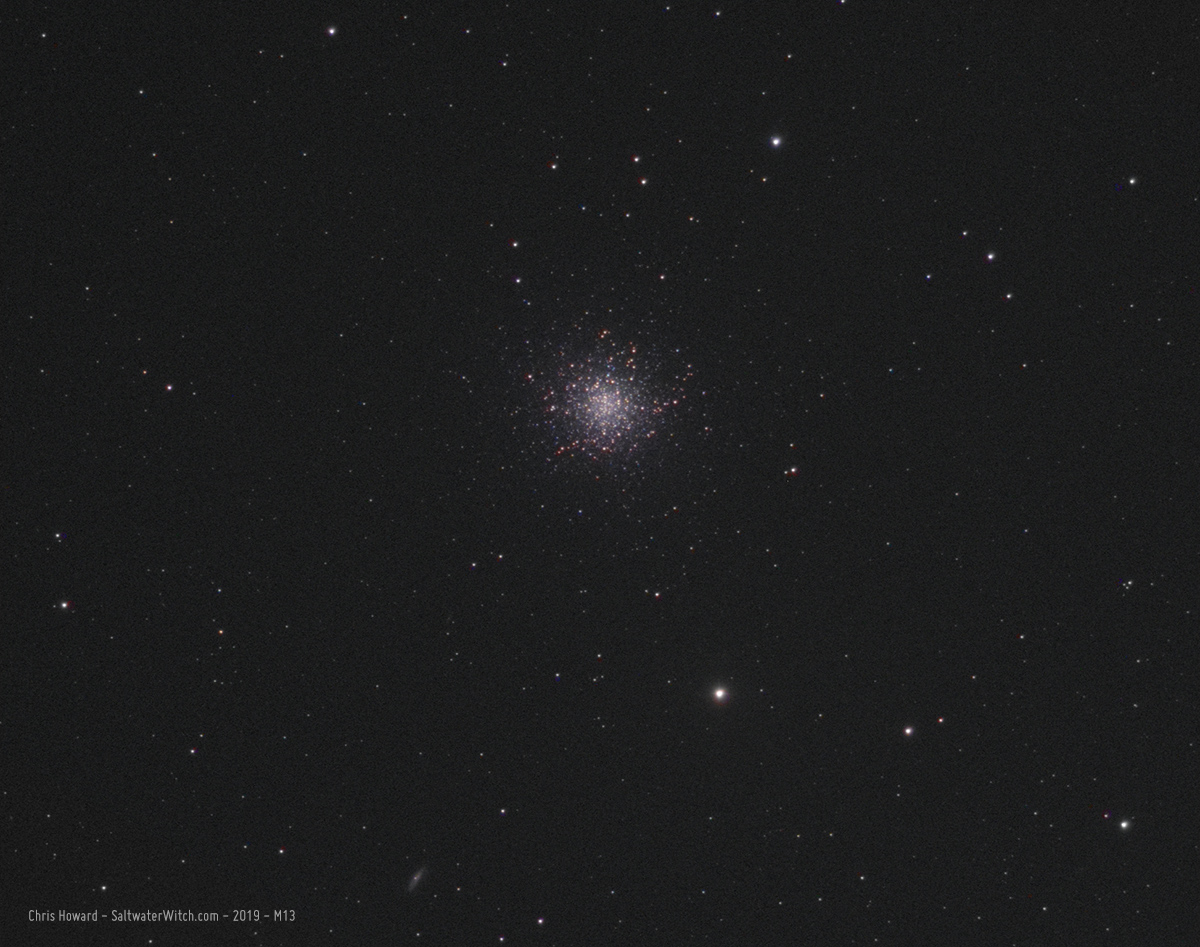
Messier 12 Cluster:
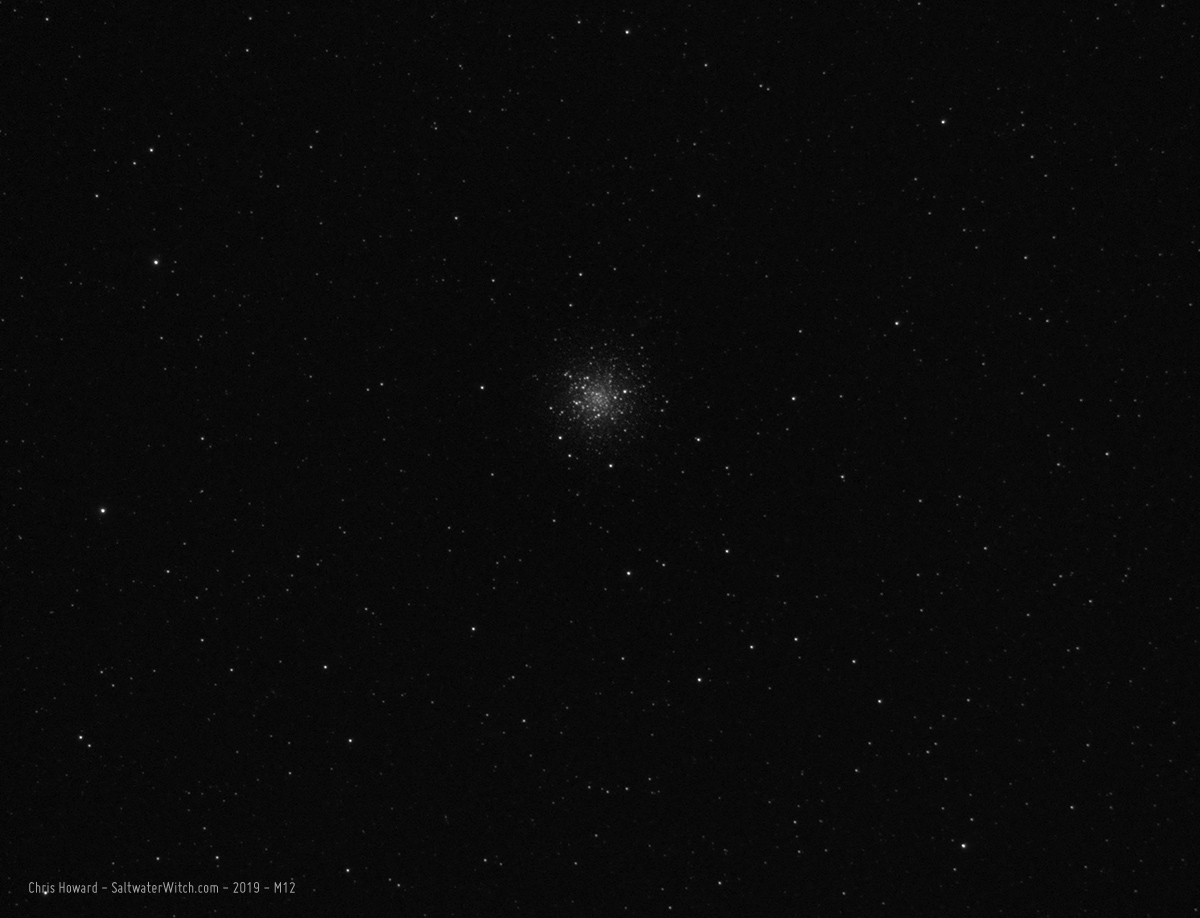
Posted May 23, 2019
Astro Session - April 22, 2018
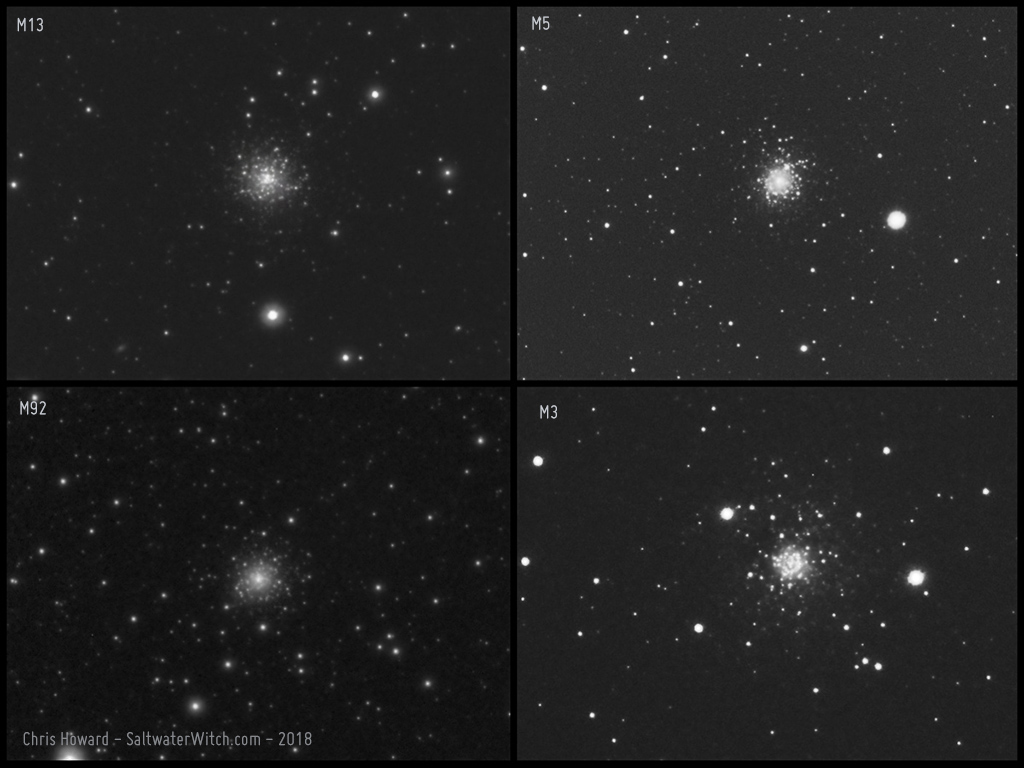 Although the skies were clear last night, the "seeing" wasn't great--"seeing" refers to the amount of atmospheric interference from temperature changes, convection currents, and other funny stuff going on in the air above your telescope. I did get to test out the Pentax 200mm f/4 lens with the Atik 414EX monochrome CCD, and an Ha longpass filter. These clusters are fairly small, so this isn't a very good setup for shooting them, but here you go anyway. Top left: the 300,000 stars that make up Messier 13 (NGC 6205), a globular cluster in the constellation Hercules. Messier 5 in the constellation Serpens. The M3 globular cluster the constellation Canes Venatici. Messier 92 (NGC 6341) is another cluster in the constellation Hercules.
Although the skies were clear last night, the "seeing" wasn't great--"seeing" refers to the amount of atmospheric interference from temperature changes, convection currents, and other funny stuff going on in the air above your telescope. I did get to test out the Pentax 200mm f/4 lens with the Atik 414EX monochrome CCD, and an Ha longpass filter. These clusters are fairly small, so this isn't a very good setup for shooting them, but here you go anyway. Top left: the 300,000 stars that make up Messier 13 (NGC 6205), a globular cluster in the constellation Hercules. Messier 5 in the constellation Serpens. The M3 globular cluster the constellation Canes Venatici. Messier 92 (NGC 6341) is another cluster in the constellation Hercules.
